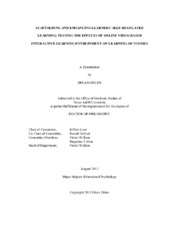| dc.description.abstract | Online learning often requires learners to be self-directed and engaged, and I designed an online video-based interactive learning tool to support or scaffold students’ self-regulated or self-directed learning aimed at keeping students actively engaged with the content. Using an experimental design, this study investigates the effects of a newly designed online video-based interactive learning environment with embedded supports for self-regulation strategies on students’ learning behaviors and outcomes. In addition, correspondence between students’ self-regulation strategies in traditional learning environments and observed self-regulated learning behaviors in the video-based interactive learning environment were examined. Lastly, the unique or joint contributions of the embedded supports for self-regulation strategies to students’ learning performance were examined. A cross-sectional experimental research design with systematic random assignment of participants to either the control condition (non-interactive video environment) or the experimental condition (interactive video environment) was utilized. Undergraduate and graduate students participated in the study (N = 80). Study results indicate that the newly designed online video-based interactive learning environment was a superior instructional tool than the non-interactive video-based learning environment in terms students’ learning performance. In addition, there was correspondence between graduate students’ self-reported self-regulation and observed self-regulation, with those high on seeking/learning information and managing their environment/behavior more likely to engage more in interactive note-taking Importantly, these findings suggest that specific self-regulation strategies in traditional education settings may transfer and become enacted as specific learning behaviors in the online learning environment. Finally, the use of embedded self-regulatory functions did not have a significantly unique contribution to students’ performance in the interactive learning environment. In other words, although the interactive learning environment succeeded in scaffolding and supporting students’ learning process that resulted in superior performance than the non-interactive learning environment, none of the embedded functions appear to uniquely or individually contribute to this superior performance.
In sum, students benefited from the online video-based interactive learning environment by using embedded self-regulatory functions. However, use of the embedded self-regulatory functions did not uniquely contribute to learning outcomes. Nonetheless, results support the view that interactivity based on self-regulation strategies supports active and engaged learning, which contributes to superior learning outcomes. | en |


